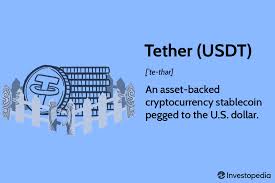USDT (Tether) is the most widely used stablecoin in the cryptocurrency market. Designed to maintain a 1:1 peg with the US dollar, it provides stability in the highly volatile crypto space. Traders and investors use USDT to hedge against market fluctuations, facilitate quick transactions, and store value without exiting the crypto ecosystem.
In this article, we’ll explore what USDT is, how it works, its benefits, risks, and frequently asked questions (FAQs).
USDT is a stablecoin issued by Tether Limited. Unlike Bitcoin or Ethereum, which experience significant price swings, USDT is pegged to the US dollar, meaning 1 USDT = $1. This stability makes it a popular choice for trading, remittances, and decentralized finance (DeFi) applications.
- Stable Value: Backed 1:1 by reserves (cash, bonds, and other assets).
- Wide Adoption: Available on multiple blockchains (Ethereum, Tron, Solana, etc.).
- Liquidity: Highly liquid, making it easy to trade for other cryptocurrencies.
- Fast Transactions: Enables quick and low-cost transfers compared to traditional banking.
Tether claims that each USDT is backed by reserves, including:
- Cash & Cash Equivalents (e.g., USD in bank accounts)
- Commercial Paper & Bonds (short-term debt instruments)
- Other Assets (loans, investments)
However, Tether has faced scrutiny over its reserve transparency. Regular audits and attestations are conducted to ensure sufficient backing, but critics argue for more transparency.
✅ Stability: Avoids volatility while staying in the crypto market.
✅ Fast & Cheap Transfers: Ideal for cross-border payments.
✅ Trading Pair: Most exchanges use USDT as a base trading pair (e.g., BTC/USDT).
✅ DeFi & Yield Farming: Used in lending, staking, and liquidity pools.
⚠️ Centralization Risk: Tether Limited controls issuance and reserves.
⚠️ Regulatory Scrutiny: Governments may impose restrictions on stablecoins.
⚠️ Reserve Transparency: Past controversies raise questions about full backing.
⚠️ Black Swan Events: If confidence drops, USDT could lose its peg.
No, USDT is a cryptocurrency pegged to the USD but is not legal tender. It operates on blockchain networks, whereas USD is issued by the US government.
- USDC: More transparent, regulated by US authorities.
- DAI: Decentralized, backed by crypto collateral.
- BUSD: Issued by Binance but discontinued in 2023.
Yes, in extreme cases (e.g., loss of trust, regulatory crackdowns), USDT can deviate from $1, as seen briefly in past crises.
You can buy USDT on:
- Centralized exchanges (Binance, Coinbase, Kraken)
- Decentralized exchanges (Uniswap, PancakeSwap)
- Peer-to-peer (P2P) platforms
While widely used, USDT carries risks like regulatory changes or reserve issues. Diversifying with other stablecoins (USDC, DAI) may reduce exposure.
Tether earns from:
- Interest on reserve assets
- Fees for issuing and redeeming USDT
Yes, some merchants accept USDT, but it’s primarily used for trading and DeFi.
If Tether collapses, USDT holders may face redemption issues. Exchanges could freeze trading, leading to market instability.
Tether can mint new USDT based on demand, but since it’s pegged to USD, inflation depends on the US dollar’s value.
Tether publishes periodic attestation reports (not full audits) on its official website.
USDT remains a cornerstone of the crypto economy, offering stability and liquidity. However, users should stay informed about risks and regulatory developments. For maximum security, consider diversifying across multiple stablecoins and keeping funds in self-custody wallets when possible.

